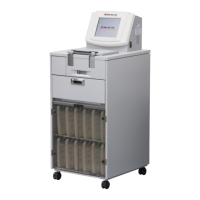1. Installation Method
1-2
2) Checking the Installation Conditions
Checking the installation location
Confirm beforehand that the location is flat, strong and meets
the dimensions of installation location (installation space)
shown in the figure on the right. Also confirm that no space is
left at the rear of the instrument which will be used for people
to pass through frequently (recommended). Confirm that no
foreign objects that may block the air outlets of the instrument
(such as hanging towels, etc.) are present in and around the
installation location.
Checking the facility-side power supply
Confirm that the facility-side power supply conforms to the
requirements.
The instrument can support the power supplies listed below using the selector switches.
Switching of the voltage setting should only be performed by qualified service staff working exclusively
with the instrument.
• Single-phase 100 VAC 10%
• Single-phase 15 VAC 10%
• Single-phase 220 VAC ~ 240 VAC 10%
If the above facility requirements are not satisfied (such as when the power supply used is 200 VAC),
the instrument must not be used.
If the instrument generates abnormality, the breaker on the facility side may actuate and other
equipment may be affected; accordingly, connect each instrument to a dedicated power outlet
(including a dedicated breaker on the facility side).
• Specification of the power cord supplied with the instrument
UL/CSA, PSE approved product
Cord: CENELEC HD, VDE approved
Plug: EN, IEC, VDE
Connector: EN, VDE approved
If the instrument is used in a region where the applicable standard above is not met, provide a different
power cord conforming to the standard in the location of use.
• About grounding
Confirm with the person responsible for the facility that the power outlet to be used is grounded (100 or less).
Confirming a ventilation system, local exhaust system or exhaust port on the facility side
Although the volumes of volatile solution gases released from the instrument vary depending on the solutions
and processing programs used and the environmental temperature, volumes of gases released per unit time are
provided below for reference. Based on these values and the volumetric size of the installation location, check if
the ventilation rate is sufficient to meet the requirements at the installation location pertaining to the
concentrations of substances in the work environment. If ventilation facility is not available, connect the optional
duct connection adapter and exhaust duct hose set to the exhaust port of the instrument so as to release the
exhaust gases to the outdoors, or otherwise confirm that the instrument can be operated in such a way that the
concentrations of volatile solution gases in the work environment meet the standards at the installation location.
Maximum volumes of gases released per
unit time (reference)
Formaldehyde: 10.40×10
-6
(m
3
/hr)
Ethanol: 1.02×10
-2
(m
3
/hr)
Xylene: 4.05×10
-4
(m
3
/hr)
The volumes of volatile solution gases released
from the instrument vary depending on the
solutions and environment.

